I'm still searching for photos of the Central Police Station, Magistracy, and Prison [1]. Here are some of the photos I've found, and also a few questions that they've raised. Thank you to everyone who has helped so far, and any extra offers of help will be very gratefully received!
The Central Police Station and its parade ground
Here's an old postcard view that was sent by reader 'moddsey':
The policemen are lined up on the parade ground, in front of the Barracks Block.
We'd originally dated this photo to the 1910s, but I'll have to update that. The Barracks Block had a fourth storey added in 1909, so this view of the original 3-storey building must have been taken earlier.
A photographer would usually be present for the big events held here. They weren't always professional photographers though. The next photo was taken in 1917 by Harry Ching [2]. It was sent in by his son Henry, who says his father was a keen amateur photographer.
The Police Reserve was formed in 1914 to help replace the policemen who went back to Europe to fight in World War 1. Reader '1314' gives a likely explanation of the event being photographed above:
Names of 30+ HK Citizens who ' declared themselves willing to be formed into the Special Police Reserve under Special Police Reserve Ord 1914 (Ord 27/1914)' can be found in HK Gazette of 5.2.1915 G.N 57. The Special Police Reserve was renamed the Police Reserve in 1917, so the photograph could well be in connection with a disbandment - renaming - reformation parade.
The open space was also a good setting for smaller, group photos:
The photo [3] is courtesy of Michael Martin. He says it is a "1940 group photo of HK Police and reservists" which shows Michael's grandfather, AJ Savitsky, in the second row. Less than two years later, Savitsky and many of the other men shown here were interned in Stanley camp by the Japanese.
Q1. Do you have any group photos taken in the parade ground?
You might think that we have enough already, but if you have any I'd love to see them. Apart from the people in the photos, when the photos are sharp we also get to see how the buildings looked at different times.
e.g. start again with the first photo, but this time we'll focus on the buildings. We're standing in the parade ground, looking south-west towards the original 3-storey Barracks Block:
Imagine turning to your left, and you'd see the 1917 view:
On the right is the edge of the Barracks Block. It's a pity we can't see its full height, or we'd be able to see the new storey on top.
Just to its left is the back wall of the Magistracy. It was finished in 1914, so it was another new building in the photo.
Left again, and the other building in this photo is the L-shaped Married Inspectors' Quarters building.
Then walk sideways, a few paces to your left, so you're facing the end of the Married Inspectors' Quarters building:
The small building on the left with the pitched roof is the Married Sergeants' Quarters. Modern photos show it is covered in a thick whitewash, but here we can see it was originally just plain brick.
Q2. Do you have any photos taken inside the buildings?
These are even rarer than outdoors photos, so any internal views will be very valuable.
Policemen
A couple of questions popped up as we've been looking at photos of policemen.
Q3. Did all Indian policemen wear turbans?
Here's a photo dated 1913 from the Hong Kong Public Library collection [4]. The standing policemen on either end are in the Chinese policeman's uniform, while the three men standing in the centre are Indian:
Originally I thought that Indian policemen wore turbans because they followed the Sikh religion. But many Indian policement were Muslim, yet every photo of an Indian policeman I've seen shows them wearing a turban. So was it just part of the standard uniform, regardless of their religion?
Apart from headgear, I'm also interested in the number each policeman wore on his collar.
Q4. Each policeman wore a number on their collar. Are they unique, and does anyone know the dates that a given range were issued?
This photo from John Breen's collection shows a Chinese policeman wearing number 132:
If they were unique, and if they were issued in ascending order, and if we knew when a certain range (eg 1..99, 100..199, etc) was issued, we could use the numbers to help date any photos they appear in. That's a lot of ifs, but hopefully one of our knowledgeable readers knows the answers!
The Magistracy
If you were caught by the police, there's a good chance you'd end up on trial in the Magistracy. The building that we see today is the third Magistracy building within the CPS compound area, and the second on this site.
We caught a glimpse of it in the 1917 photo above, but that was just the plain back wall. The more imposing facade was saved for side that faces the public, shown here in a photo from the HK Public Library's collection [5]:
Then what did the previous building look like?
Q5. Does anyone have a good photo of the facade of the previous building on this site, the second Magistracy building?
If there's a close-up view like the one above, that would be ideal. I haven't seen one yet though, so I'll settle for a distant but sharp view of Central from the east, where we can crop it to show the magistracy. Something like this photo in the UK National Archive (the Magistracy building is indicated by the middle vertical line):
Before we leave the Magistracy, another question I'm curious about:
Q6. Who was Arbuthnot Road named after?
It's the road that runs in front of the Magistracy building, linking Caine Road and Hollywood Road. Wikipedia suggests it was named after George Arbuthnot, but I'm not convinced by the explanation given there. If you'd like to join in the discussion about this, please see http://gwulo.com/node/15229.
Punishment: stocks and the cangue
One of the gentler punishments the magistrate could give out was to put you on display in the stocks or the cangue. The stocks fastened around the legs:
And to make sure there was no doubt about your crime, it was written on the board we can see resting on the criminals' laps.
The stocks were a familiar punishment in Britain, but the Chinese equivalent was known as the Cangue. A cangue is a wooden board in two halves that fasten around the neck. It had the stocks' embarrassment factor, but with added discomfort, and as a bonus the wide board meant you were unable to feed yourself:

This copy of the photo is displayed in the Virtual Shanghai website [6]. I was excited to see another copy of the same photo, with "convicts in Victoria Prison" written on the back. However we've since decided that the photo was taken outside Hong Kong, and mislabelled [7].
Then how about the photo we showed earlier:
It appears to show the cangue in Hong Kong - at least the policeman looks to be wearing a Hong Kong uniform. But we haven't found any good evidence that the cangue was used in Hong Kong after the 1840s. So this may have been a posed photograph for the benefit of a commercial photographer, rather than an actual event.
Q7. When was the cangue used as punishment in Hong Kong?
That would help answer the question about the photo above. If you know, please join the discussion about the use of the cangue at: http://gwulo.com/node/15121
The stocks and the cangue were certainly unpleasant, but harsher punishments were used too, included flogging and / or time in Victoria Prison.
Q8. Have you seen any photos of the flogging post?
I have been shown one that was in an exhibition, but haven't reached the owner yet. If you know of any photos, please let me know.
Victoria Prison
Although we're calling the site the Central Police Station Compound, the Police were relatively late to move in. The first buildings on the site were the Magistracy and the Prison (then called the Gaol).
These 19th-century photos in the UK National Archive were taken from Chancery Lane, and show the prison buildings that were completed in 1858:
The two large buildings running left to right across the bottom photo are still standing today. They are the oldest remaining buildings on the site, and are known as "D Hall".
For a very different view of life in the prison, how about:
Forget the cangue, your punishment is ten-thousand twirls of the hula-hoop...
This photo is courtesy of local writer, Kate Whitehead. Kate lived in a flat overlooking the prison in the summer of 2005, just before the prison was decommissioned. Aware that this was a historic time, she left a digital camera on her windowsill to remind herself to take regular photos of whatever was going on in the prison yard.
She says the noise drifting up from the prison yard was surprisingly cheerful - more like a school-playground than anything else. At that time the female inmates were mainly young women from the mainland. They'd been working as prostitutes in Hong Kong, overstayed their visa, been caught and given a short sentence here.
As far as Kate could tell, every inmate was issued a hula-hoop, as that's what they used to pass the time. The stylised photo above shows one of the more advanced inmates, showing off her double-hoop skills! (If the photo seems familiar, Kate exhibited them at the Fringe Club in 2005 as limited-edition prints.)
I hope you've enjoyed these. If you know of any more photos of the CPS compound (police station, magistracy or prison), or you can help answer any of the questions, please get in touch. You're welcome to leave a comment below, or please send me an email at:
Regards, David
Trivia:
One more photo of the stocks sent in by reader 'Moddsey', which he found on the internet some years ago:
Very obviously a posed photo! I'd be interested to hear the story behind it if anyone knows it.
References:
- Read about the background to this project at: http://gwulo.com/node/14719
- Harry Ching
- See the 1940 photo of Police and reservists, annotated with a fiull list of names, at http://gwulo.com/node/14770
- To find this photo, search the HKPL photo collection for cataloguing text: "Group pictured outside Pokfulam Police Station in 1913"
- To find this photo, search the HKPL photo collection for cataloguing text: "Former Central Magistracy, Arbuthnot Road, Central"
- http://www.virtualshanghai.net/Photos/Images?ID=25296
- Reasons the photo in [6] was unlikely to have been taken in Hong Kong: http://gwulo.com/node/15121#comment-23975

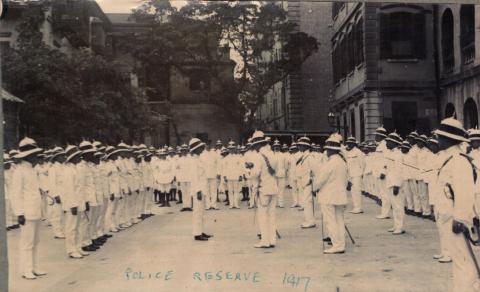
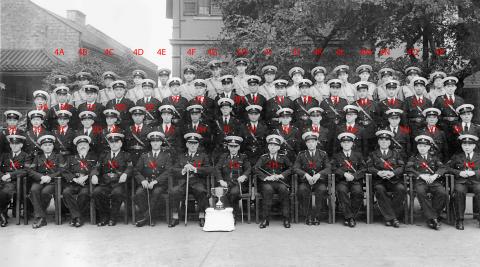
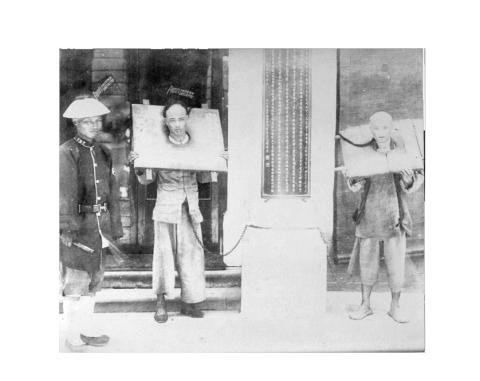

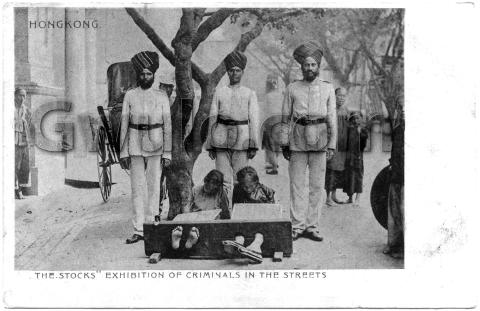
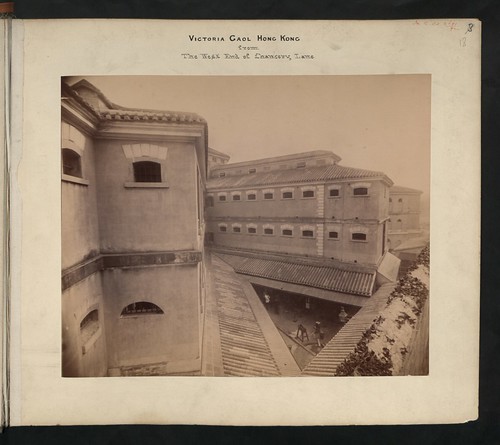
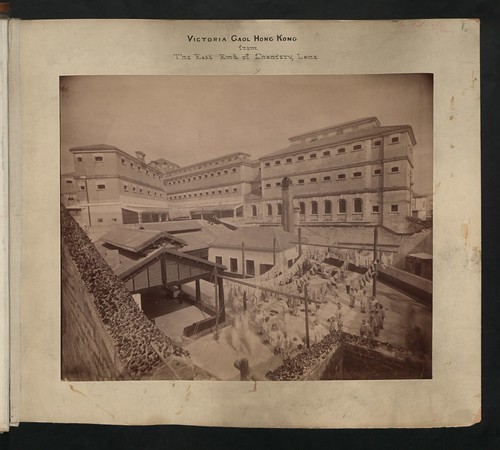
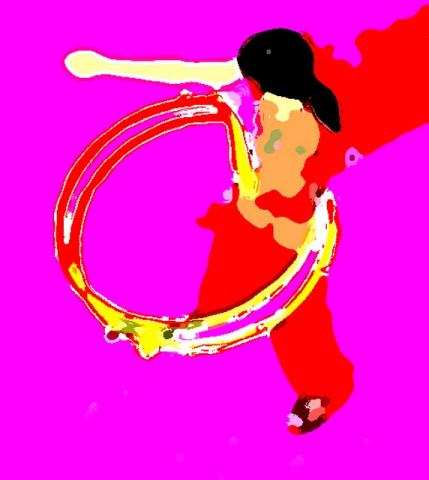
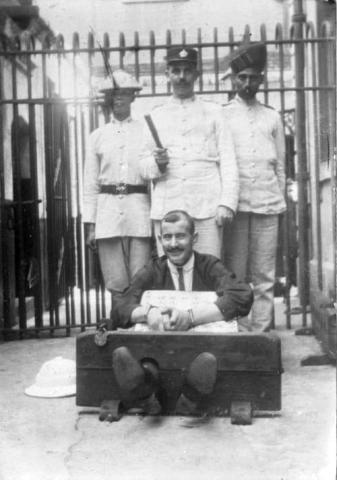
Comments
Gaol Photo
David, I think you'll find that those gaol buildings weren't completed until the early 1860s, not 1858. It was December 1858 that the designs, attached to the despatch below, were first sent to London for approval.
CO 129/69, pp 614-620
[from: 1858-12-29 to: 1858-12-29]
Document: PLAN FOR THE EXTENSION OF VICTORIA GAOL
Microform: HKU 2507093
From: CAINE
Send to: LYLTON
Encl: ENCLOSURE=3 *PLAN FOR THE EXTENSION OF VICTORIA GAOL WITH LETTERS OF THE SURVEYOR GENERAL IN EXPLANATION.
Keyword(s): PLAN, EXTENSION, VICTORIA, GAOL, SURVEYOR GENERAL,
re: Gaol Photo
Hi Adam, I've had a bit more of a dig around and you're absolutely right. It looks as though those buildings were completed in the first half of 1862.
Thanks for the correction,
Regards, David
Gaol Buildings
Hi David, It was a big project and I think would have opened gradually, block by block. Secondary-sources (the usual suspects) give various dates from 1862 to 1867. Primary sources are harder to come by, especially as newspapers and govt. dept. reports for that period are harder to come by than usual (there may be something in Blue Books). And I guess a gaol was unlikely to have had a grand opening in those days. And of course, the gaol itself was a work in progress pretty much up until the time it closed as such in 1937.
Victoria Gaol
1900s Victoria Gaol
re: Victoria Gaol
Thanks Moddsey. Thanks also to Tim, who sent in another copy of this postcard by email.
Regards, David
Re: Photo of Prisoners in Cangue with Policeman
The captioned photo can be seen here from the Mary Evans Archives and indicates the location was in China.
Search for the Hong Kong collection as there are engravings, sketches and photos of early Hong Kong and photos of Cheung Chau in the early 1950s.
1900s Central Police Station
The Central Police Station can be seen here